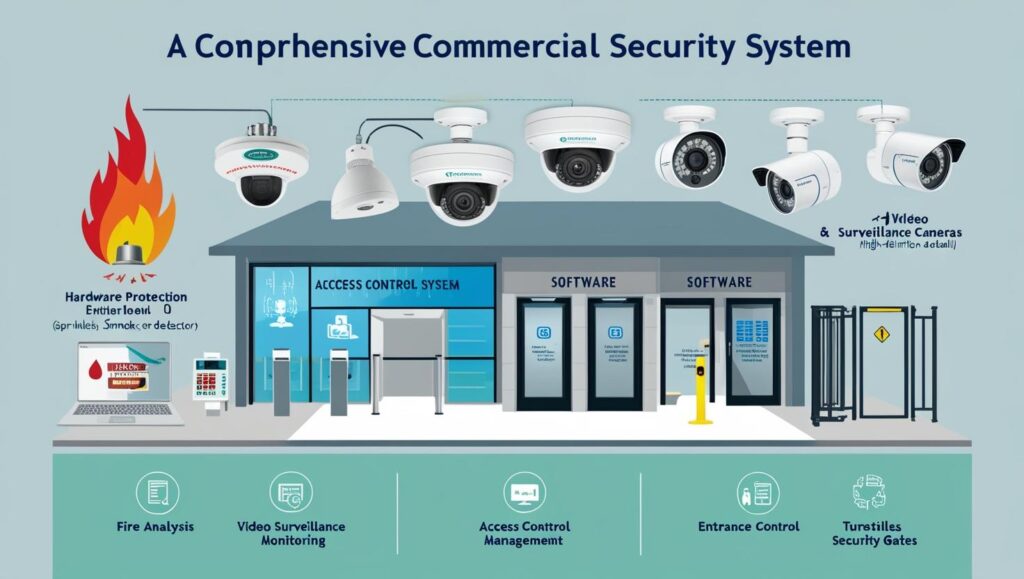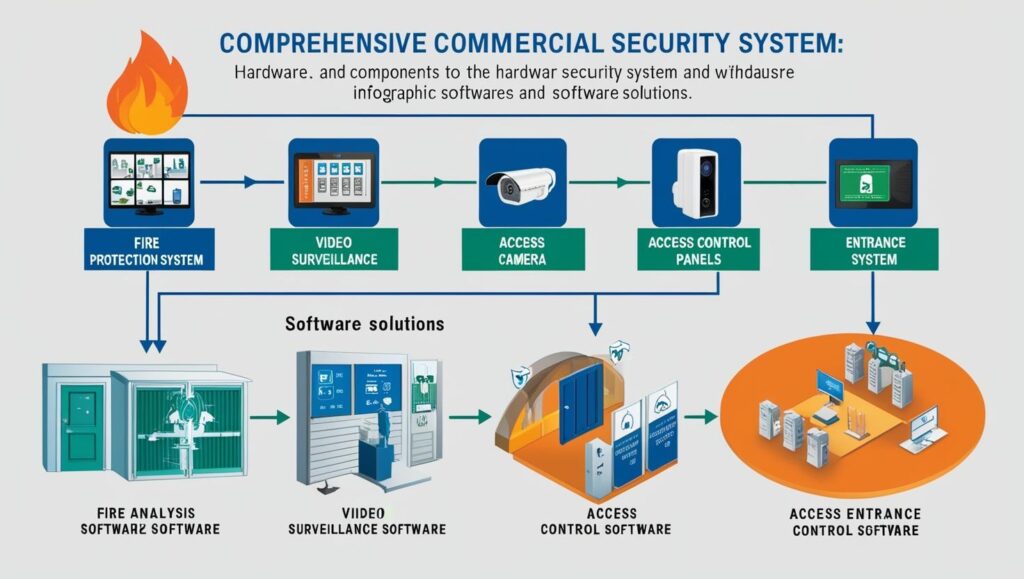The commercial security systems market in North America is experiencing significant growth, driven by a variety of factors including technological advancements, increasing concerns about safety, and the rising need for sophisticated, integrated security solutions. The demand for more advanced commercial security systems is escalating as businesses face new challenges in protecting assets, data, and personnel. As a result, the market for security solutions across industries like retail, healthcare, education, and corporate enterprises is evolving rapidly. This article explores the key trends driving demand for advanced commercial security solutions in North America.
Global Commercial Security System Market Size
The Global Commercial Security System Market Size is expected to reach USD 343.7 Billion by 2028 from USD 236.3 Billion in 2023, growing at a CAGR of 7.8% during the 2023–2028 period. A commercial security system refers to a collection of security measures implemented in a commercial setting to safeguard individuals, communities, residences, personal belongings, or organizations from potential harm. To counteract such threats, a variety of security products are utilized. The demand for security systems has risen due to the need for protection against increasingly prevalent threats, heightened consumer awareness and concerns regarding security, and the willingness to invest in security measures. The report covers several security products, including fire protection systems, video surveillance, access control systems, entrance control systems, remote monitoring services, and security system integration services.

1. Increasing Integration of IoT in Security Systems
One of the most transformative trends in the commercial security systems market is the increasing integration of the Internet of Things (IoT). IoT-enabled security systems offer greater flexibility, scalability, and control by connecting various devices—such as cameras, alarms, door locks, and access control systems—into a unified network.
Benefits of IoT integration:
Real-time Monitoring and Control: Businesses can monitor their premises from any location via mobile apps or web-based interfaces.
Automation: IoT-enabled systems can be programmed to automatically perform certain functions, such as locking doors or turning off lights after hours.
Enhanced Data Analytics: IoT devices can collect data on security events, providing insights into patterns and potential vulnerabilities.
As commercial spaces increasingly embrace smart technology, the demand for IoT-based security systems continues to rise, helping businesses streamline security management and improve response times.
2. Rise in Cybersecurity Threats and Data Protection Needs
As the digital landscape evolves, businesses are becoming more vulnerable to cybersecurity threats. From data breaches to ransomware attacks, the need for strong physical and digital security measures has never been more urgent. Commercial security systems in North America are shifting from traditional physical protection solutions to more integrated systems that address both physical and cyber threats.
Key developments:
Cyber-Physical Security: Modern security systems are blending cybersecurity measures (firewalls, encryption, etc.) with traditional physical security (surveillance cameras, access control) to create holistic security solutions.
Data Protection: With more businesses handling sensitive customer data, the demand for secure facilities with integrated access control, video surveillance, and intrusion detection systems is surging.
Companies in sectors such as finance, healthcare, and retail are investing heavily in advanced commercial security systems to protect valuable data and meet regulatory compliance standards, such as the General Data Protection Regulation (GDPR) and HIPAA.
Download PDF Brochure @
https://www.marketsandmarkets.com/pdfdownloadNew.asp?id=234307144
3. Advancements in Video Surveillance Technology
Video surveillance has been a cornerstone of commercial security systems for decades, but recent advancements in video technology have significantly enhanced its effectiveness. In particular, the integration of artificial intelligence (AI) and machine learning (ML) with video surveillance systems is driving demand for more advanced solutions.
Key advancements:
AI-powered Analytics: AI systems can process and analyze video footage in real-time, identifying unusual behavior, detecting intrusions, and triggering alerts. This reduces the need for manual monitoring and increases the effectiveness of surveillance systems.
High-definition (HD) and 4K Cameras: The clarity and detail offered by HD and 4K cameras allow businesses to capture and identify events with greater precision, even in low-light conditions.
Cloud-Based Video Storage: With the cloud, businesses can store vast amounts of surveillance footage securely, and access it remotely, making it easier to review footage when needed.
These technological upgrades are making video surveillance systems more efficient, cost-effective, and easier to manage, leading to their widespread adoption across commercial sectors.
4. Demand for Access Control Systems
Access control systems have evolved from simple keycard-based entry systems to sophisticated, multi-layered solutions designed to provide highly secure access to restricted areas. The need for better protection and the management of sensitive areas within commercial spaces is driving the growth of access control systems across North America.
Key drivers:
Biometric Authentication: Biometrics, such as fingerprint recognition, facial recognition, and retina scans, are becoming increasingly popular for granting secure access. These systems are harder to spoof and offer a higher level of security compared to traditional keycards or PIN codes.
Mobile Access Control: With the rise of smartphones, businesses are adopting mobile-based access control systems that allow employees and authorized personnel to access secure areas via their phones, enhancing convenience and security.
Cloud-Based Management: Cloud-based access control systems offer better scalability and remote management capabilities. Businesses can manage access remotely, granting or revoking permissions from anywhere.
With businesses placing greater emphasis on controlling access to sensitive locations—such as server rooms, cash handling areas, and private offices—the demand for these advanced access control systems is growing rapidly.

5. Increased Focus on Employee and Visitor Safety
Workplace safety and the safety of visitors have become top priorities for businesses across North America. The demand for advanced security solutions that ensure the well-being of employees and visitors is driving innovation in the commercial security systems industry.
Key trends:
Health and Safety Integration: In light of the COVID-19 pandemic, businesses are integrating security systems with health and safety measures. Features like touchless entry (e.g., face recognition or mobile access) and thermal screening are becoming standard in many commercial buildings to help reduce the spread of viruses.
Workplace Violence Prevention: Security systems are being designed to detect potential threats before they escalate. AI-powered systems can identify aggressive behaviors or potential conflicts, alerting security personnel and preventing incidents.
Emergency Notification Systems: Advanced commercial security systems now include integrated emergency notification capabilities that can alert employees and visitors in case of a fire, active shooter situation, or other emergency.
As workplace safety concerns continue to rise, businesses are adopting security systems that not only protect assets but also ensure the safety of everyone on the premises.
6. Growing Use of Cloud-Based Security Solutions
Cloud-based commercial security systems are rapidly gaining traction in North America. Cloud solutions offer a range of benefits over traditional on-premise systems, including flexibility, scalability, and cost-effectiveness.
Benefits include:
Remote Access and Monitoring: Cloud systems allow businesses to monitor and manage their security infrastructure from anywhere, providing enhanced flexibility for businesses with multiple locations.
Scalability: Cloud-based solutions can be easily scaled to accommodate growing businesses without the need for significant infrastructure investments.
Lower Upfront Costs: By eliminating the need for expensive hardware installations and reducing maintenance costs, cloud-based systems are more affordable for small and medium-sized businesses.
As businesses continue to prioritize digital transformation and embrace cloud technologies, demand for cloud-based commercial security systems is expected to keep growing.
Conclusion: The Future of Commercial Security in North America
The North American commercial security systems industry is evolving rapidly, driven by advancements in IoT, AI, video surveillance, access control, and cloud-based solutions. With increasing concerns over safety, data protection, and employee welfare, businesses across the region are adopting more sophisticated, integrated security systems to protect their assets, data, and personnel.
The future of commercial security in North America will be defined by smarter, more connected, and more responsive systems that offer real-time insights, proactive threat detection, and seamless user experiences. As technology continues to advance, businesses must stay ahead of security challenges by embracing the latest innovations to ensure their physical and digital environments remain secure in an increasingly complex world.
About MarketsandMarkets™
MarketsandMarkets™ has been recognized as one of America’s Best Management Consulting Firms by Forbes, as per their recent report.
MarketsandMarkets™ is a blue ocean alternative in growth consulting and program management, leveraging a man-machine offering to drive supernormal growth for progressive organizations in the B2B space. With the widest lens on emerging technologies, we are proficient in co-creating supernormal growth for clients across the globe.
Today, 80% of Fortune 2000 companies rely on MarketsandMarkets, and 90 of the top 100 companies in each sector trust us to accelerate their revenue growth. With a global clientele of over 13,000 organizations, we help businesses thrive in a disruptive ecosystem.
The B2B economy is witnessing the emergence of $25 trillion in new revenue streams that are replacing existing ones within this decade. We work with clients on growth programs, helping them monetize this $25 trillion opportunity through our service lines – TAM Expansion, Go-to-Market (GTM) Strategy to Execution, Market Share Gain, Account Enablement, and Thought Leadership Marketing.
Built on the ‘GIVE Growth’ principle, we collaborate with several Forbes Global 2000 B2B companies to keep them future-ready. Our insights and strategies are powered by industry experts, cutting-edge AI, and our Market Intelligence Cloud, KnowledgeStore™, which integrates research and provides ecosystem-wide visibility into revenue shifts.
In addition, MarketsandMarkets SalesIQ enables sales teams to identify high-priority accounts and uncover hidden opportunities, helping them build more pipeline and win more deals with precision.
To find out more, visit www.MarketsandMarkets™.com or follow us on Twitter , LinkedIn and Facebook .
Contact:
Mr. Rohan Salgarkar
MarketsandMarkets™ INC.
1615 South Congress Ave.
Suite 103, Delray Beach, FL 33445
USA: +1-888-600-6441
Visit Our Website: https://www.marketsandmarkets.com/
